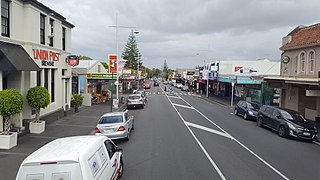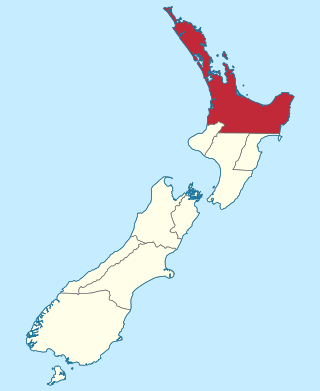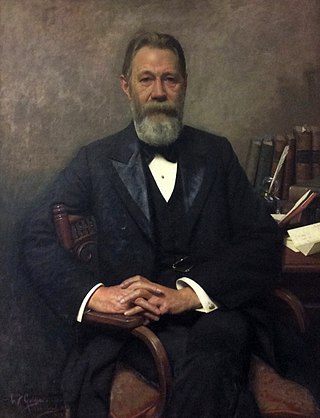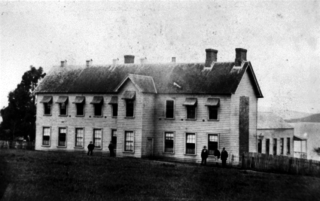
Grey Lynn is an inner suburb of Auckland, New Zealand, located 3 kilometres (1.9 mi) to the west of the city centre. Originally a separate borough, Grey Lynn amalgamated with Auckland City in 1914.

Ponsonby is an inner-city suburb of Auckland located 2 km west of the Auckland CBD. The suburb is oriented along a ridge running north–south, which is followed by the main street of the suburb, Ponsonby Road.

Ellerslie is a suburb of the city of Auckland, in the North Island of New Zealand. Ellerslie lies seven kilometres to the southeast of the city centre, close to State Highway 1.

Saint Marys Bay is an inner suburb of Auckland, New Zealand.

Auckland Art Gallery Toi o Tāmaki is the principal public gallery in Auckland, New Zealand. It has the most extensive collection of national and international art in New Zealand and frequently hosts travelling international exhibitions.

The Auckland Province was a province of New Zealand from 1853 until the abolition of provincial government in 1876.
Edward Bartley was a Jersey-born New Zealand architect. Beginning as a builder, Bartley transitioned into a career as an architect, not an uncommon occurrence in the 19th century. He is responsible for designing more than 20 churches and some of Auckland's most notable buildings.

Dunedin Public Libraries is a network of six libraries and two bookbuses in Dunedin, New Zealand, owned and operated by the Dunedin City Council. The Libraries' collection includes over 700,000 items, and around 30,000 books and audiovisual items plus 15,000 magazines are added each year. Members can borrow or return items from any library or bookbus in the network.

Auckland Council Libraries, usually simplified to Auckland Libraries, is the public library system for the Auckland Region of New Zealand. It was created when the seven separate councils in the Auckland region merged in 2010. It is currently the largest public-library network in the Southern Hemisphere with 55 branches from Wellsford to Waiuku. Currently from March 2021, the region has a total of 56 branches.

The Carnegie Library is in Egerton Street, Runcorn, Cheshire, England. It is recorded in the National Heritage List for England as a designated Grade II listed building and "possesses special architectural and historic interest within a national context". It was built in 1906 as an extension to Waterloo House and the existing library with a grant from Andrew Carnegie, and closed in 2012.

Cecil Walter Wood was a New Zealand architect. He was the dominant architect in Canterbury during the interwar period.

Thomson Wilson Leys was a New Zealand journalist, editor, newspaper proprietor and philanthropist. He was born in Sneinton, Nottinghamshire, England on 23 April 1850.
William Alfred Holman was a New Zealand architect and a member of the New Zealand Institute of Architects who designed prominent commercial and residential buildings in Auckland as well as Whangārei, Hamilton, Gisborne and Christchurch.

The General Assembly House, colloquially called "Shedifice" by the members of Parliament, was the first building to house the New Zealand Parliament in Auckland. It was in use by Parliament from 1854 until 1864 during the time that Auckland was the capital of New Zealand. It was also used by the Auckland Provincial Council, with Auckland Province owning the building from 1858. After the abolition of the provincial government system, the building was used by the government's survey department and was then used by Auckland University College. The General Assembly House was demolished in 1917 to make way for Anzac Avenue. Today, a reserve adjacent to Parliament Street called Parliament Reserve commemorates the location where the New Zealand Parliament met initially.

Lytham library was built originally as a Mechanics Institute. It included a small library of books and a reading room and opened on 30 August 1878. The building was extended in 1898 to celebrate Queen Victoria's Diamond Jubilee, including a new reading room, gymnasium and classrooms. The extension was opened by the Duke of Norfolk. In 1922 the library became part of the Municipal Borough of Lytham St Annes with the amalgamation of St Anne's on the Sea and Lytham Urban District Councils. In 1974 the administration of the library was taken over by Lancashire County Council. In Buildings of England Hartwell and Pevsner describe its 'Dark red and yellow and black brick dressings, including dentil sill bands and 'quoins'. Steep coped gables with jaunty finials, and lancets. Bay windows of yellow brick'.
The 1925 season of Auckland Rugby League was its 16th. On 30 March Auckland Rugby League held its fifteenth annual meeting with 200 in attendance. The strong financial position of the league was commented on. It was also decided that if possible the Senior Grade would be split into A and B divisions owing to the increasing number of teams who wished to enter but also the gap in standard between the best teams and the worst.
Arthur Matthews (1889–1951) played for the New Zealand rugby league team in 1919 on their tour of Australia. He was Kiwi number 117. He played in 3 tour matches but did not play in any tests as there were none played on this tour. He lived in Auckland and played for the Ponsonby United and North Shore Albions senior teams from 1915 to 1920.

The Westland District Library is the public library in Hokitika, on the West Coast of New Zealand. Beginning as the Hokitika Literary Society in 1866, it occupied a Carnegie library building from 1908 as the Hokitika Free Public Library, moving out in 1975.

Dunedin Athenaeum and Mechanics' Institute is an adult education institute based in a heritage building in Dunedin, New Zealand. The private organisation provided classes and a library for members. Presently it operates a subscription lending library, and includes a basement theatre that has been operated by the Dunedin Collaborative Theatre Trust since 2016. The Athenaeum building is one of the oldest athenaeums in New Zealand still used for its original purpose, and is classified as a "Category I" historic place by Heritage New Zealand Pouhere Taonga, previously known as the New Zealand Historic Places Trust.
Horace Neal was a rugby league player who represented New Zealand in one test match in 1919 against Australia at halfback. In the process he became the 128th player to represent New Zealand. He also played one match for the Auckland representative side as well as playing for the Ponsonby United, Maritime, and Grafton Athletic clubs from 1913 to 1922. Horace Neal also served in the New Zealand Expeditionary Force during World War I.


















